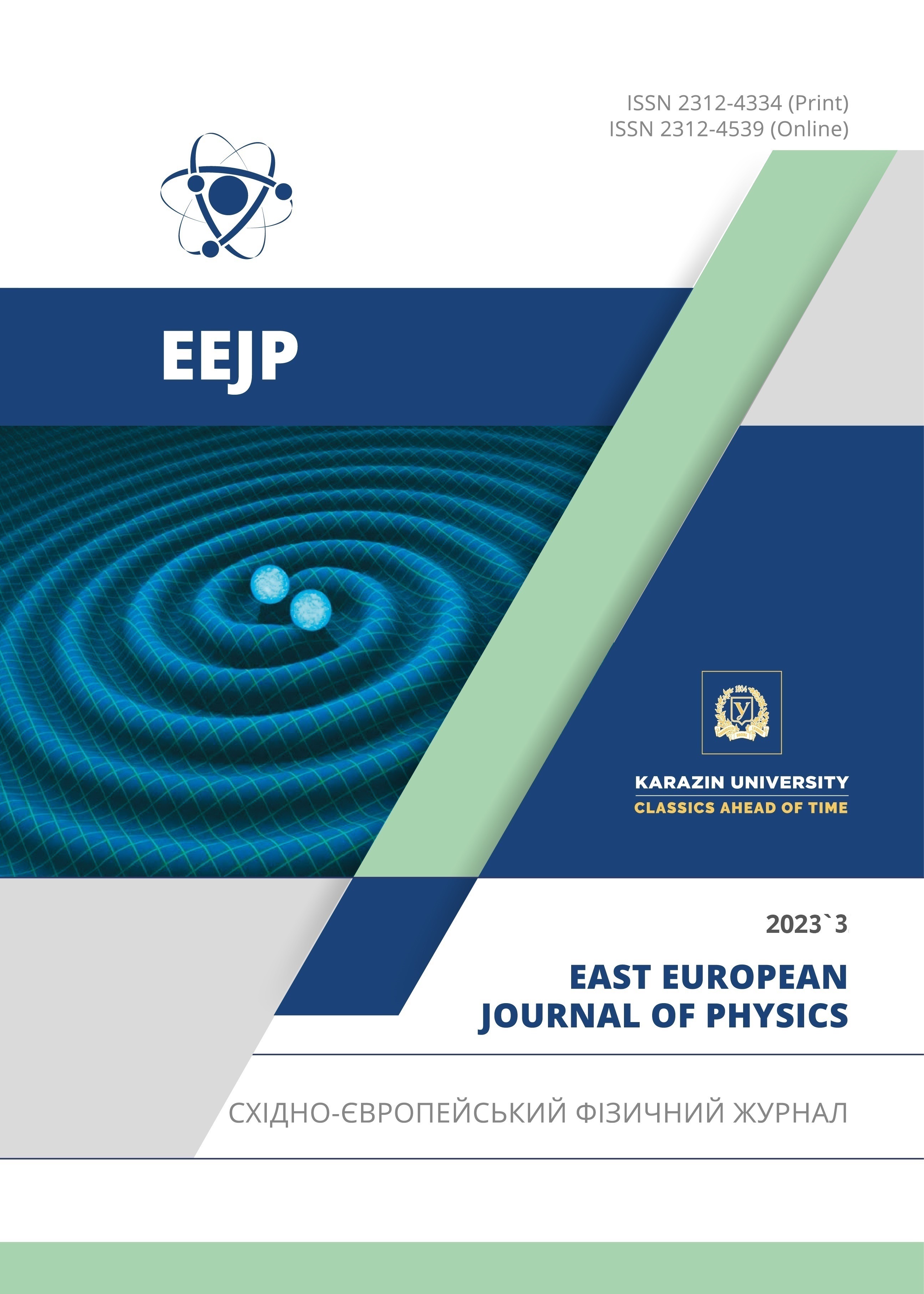Дослідження впливу концентрації наночастинок TiO2 на антикорозійні характеристики TiO2-епоксид нанокомпозитних покриттів
Анотація
Вивчені антикорозійні властивості зразків покритих TiO2-епоксид нанокомпозитами, від концентрації наночастинок TiO2 в епоксидній смолі. Антикорозійні характеристики зразків досліджували за допомогою електрохімічної імпедансної спектроскопії (EIS). Згідно з результатами EIS, зразок, що містить 0,01 мг TiO2, продемонстрував найвище значення імпедансу, що вказує на кращу стійкість до корозії та кращі антикорозійні властивості, ніж інші зразки. Крім того, цей зразок має найнижчу щільність струму корозії серед усіх зразків, зі значенням 1,329E-07 мА/см2, що показує, що цей зразок має найкращу корозійну стійкість і нижчу швидкість корозії порівняно з іншими зразками.
Завантаження
Посилання
M. Czaban, “Aircraft corrosion - Review of corrosion processes and its effects in selected cases,” Fatigue Aircr. Struct. 10, 5-20 (2018). https://doi.org/10.2478/fas-2018-0001
H. Xu, and Y. Zhang, “A review on conducting polymers and nanopolymer composite coatings for steel corrosion protection,” Coatings, 9(12), 1-22 (2019). https://www.mdpi.com/2079-6412/9/12/807#
A. Shafaamri, R. Shafaghat, I.A.W. Ma, R. Kasi, and V. Balakrishnan, “Effects of TiO2 Nanoparticles on the Overall Performance and Corrosion Protection Ability of Neat Epoxy and PDMS Modified Epoxy Coating Systems,” Front. Mater. 6, 1–19. (2020). https://doi.org/10.3389/fmats.2019.00336
X. Zhao, S. Liu, and B.R. Hou, “A comparative study of neat epoxy coating and nano ZrO2/epoxy coating for corrosion protection on carbon steel,” Appl. Mech. Mater. 599-601, 3-6 (2014). https://doi.org/10.4028/www.scientific.net/AMM.599-601.3
F. Dolatzadeh, S. Moradian, and M.M. Jalili, “Influence of various surface treated silica nanoparticles on the electrochemical properties of SiO2/polyurethane nanocoatings,” Corros. Sci. 53, 4248-4257 (2011). https://doi.org/10.1016/j.corsci.2011.08.036
M. Heidarian, M. Shishesaz, S. Kassiriha, and M. Nematollahi, “Study on the effect of ultrasonication time on transport properties of polyurethane/organoclay nanocomposite coatings,” J. Coat. Technol. Res. 8, 265-274 (2011). http://dx.doi.org/10.1007/s11998-010-9297-7
S. Shen, and Y. Zuo, “The improved performance of Mg-rich epoxy primer on AZ91D magnesium alloy by addition of ZnO,” Corros. Sci. 87, 167-178 (2014). https://doi.org/10.1016/j.corsci.2014.06.020
E. Matin, M. Attar, and B. Ramezanzadeh, “Investigation of corrosion protection properties of an epoxy nanocomposite loaded with polysiloxane surface modified nanosilica particles on the steel substrate,” Prog. Org. Coat. 78, 395-403 (2015). http://dx.doi.org/10.1016%2Fj.porgcoat.2014.07.004
Mohamad Saidi, N., Shafaamri, A. S., Wonnie Ma, I. A., Kasi, R., Balakrishnan, V., and Subramaniam, R. “Development of anti-corrosion coatings using the disposable waste material,” Pigment Resin Technol. 47, 478-484 (2018). https://doi.org/10.1108/PRT-03-2018-0030
S. Zheng, D.A. Bellido-Aguilar, Y. Huang, X. Zeng, Q. Zhang, and Z. Chen, “Mechanically robust hydrophobic bio-based epoxy coatings for anti-corrosion application,” Surf. Coat. Technol. 363, 43-50 (2019). https://doi.org/10.1016/j.surfcoat.2019.02.020
S. Ammar, K. Ramesh, B. Vengadaesvaran, S. Ramesh, and A. Arof, “A novel coating material that uses nano-sized SiO2 particles to intensify hydrophobicity and corrosion protection properties,” Electrochim. Acta, 220, 417-426 (2016). https://doi.org/10.1016/j.electacta.2016.10.099
X. Shi, T.A. Nguyen, Z. Suo, Y. Liu, and R. Avci, “Effect of nanoparticles on the anticorrosion and mechanical properties of epoxy coating,” Surf. Coat. Technol. 204, 237-245 (2009). https://doi.org/10.1016/j.surfcoat.2009.06.048
M. Heidarian, M. Shishesaz, S. Kassiriha, and M. Nematollahi, “Characterization of structure and corrosion resistivity of polyurethane/organoclay nanocomposite coatings prepared through an ultrasonication assisted process,” Prog. Org. Coat. 68, 180 188 (2010). http://dx.doi.org/10.1016/j.porgcoat.2010.02.006
A.M. Atta, N.H. Mohamed, M. Rostom, H.A. Al-Lohedan, and M.M. Abdullah, “New hydrophobic silica nanoparticles capped with petroleum paraffin wax embedded in epoxy networks as multifunctional steel epoxy coatings,” Prog. Org. Coat. 128, 99 111 (2019). https://doi.org/10.1016/j.porgcoat.2018.12.018
J. Liqiang, S. Xiaojun, C. Weimin, X. Zili, D. Yaoguo, and F. Honggang, “The preparation and characterization of nanoparticle TiO2/Ti films and their photocatalytic activity,” J. Phys. Chem. Solids, 64, 615-623 (2003). https://doi.org/10.1016/S0022-3697(02)00362-1
G. Fu, P.S. Vary, and C.-T. Lin, “Anatase TiO2 nanocomposites for antimicrobial coatings,” J. Phys. Chem. B, 109, 8889-8898. (2005). https://doi.org/10.1021/jp0502196
P. Evans, and D. Sheel, “Photoactive and antibacterial TiO2 thin films on stainless steel,” Surf. Coat. Technol. 201, 9319-9324 (2007). https://doi.org/10.1016/j.surfcoat.2007.04.013
Авторське право (c) 2023 Ахмед Ібрагім Дауд, Ахмед Касім Абдулла

Цю роботу ліцензовано за Міжнародня ліцензія Creative Commons Attribution 4.0.
Автори, які публікуються у цьому журналі, погоджуються з наступними умовами:
- Автори залишають за собою право на авторство своєї роботи та передають журналу право першої публікації цієї роботи на умовах ліцензії Creative Commons Attribution License, котра дозволяє іншим особам вільно розповсюджувати опубліковану роботу з обов'язковим посиланням на авторів оригінальної роботи та першу публікацію роботи у цьому журналі.
- Автори мають право укладати самостійні додаткові угоди щодо неексклюзивного розповсюдження роботи у тому вигляді, в якому вона була опублікована цим журналом (наприклад, розміщувати роботу в електронному сховищі установи або публікувати у складі монографії), за умови збереження посилання на першу публікацію роботи у цьому журналі.
- Політика журналу дозволяє і заохочує розміщення авторами в мережі Інтернет (наприклад, у сховищах установ або на особистих веб-сайтах) рукопису роботи, як до подання цього рукопису до редакції, так і під час його редакційного опрацювання, оскільки це сприяє виникненню продуктивної наукової дискусії та позитивно позначається на оперативності та динаміці цитування опублікованої роботи (див. The Effect of Open Access).








